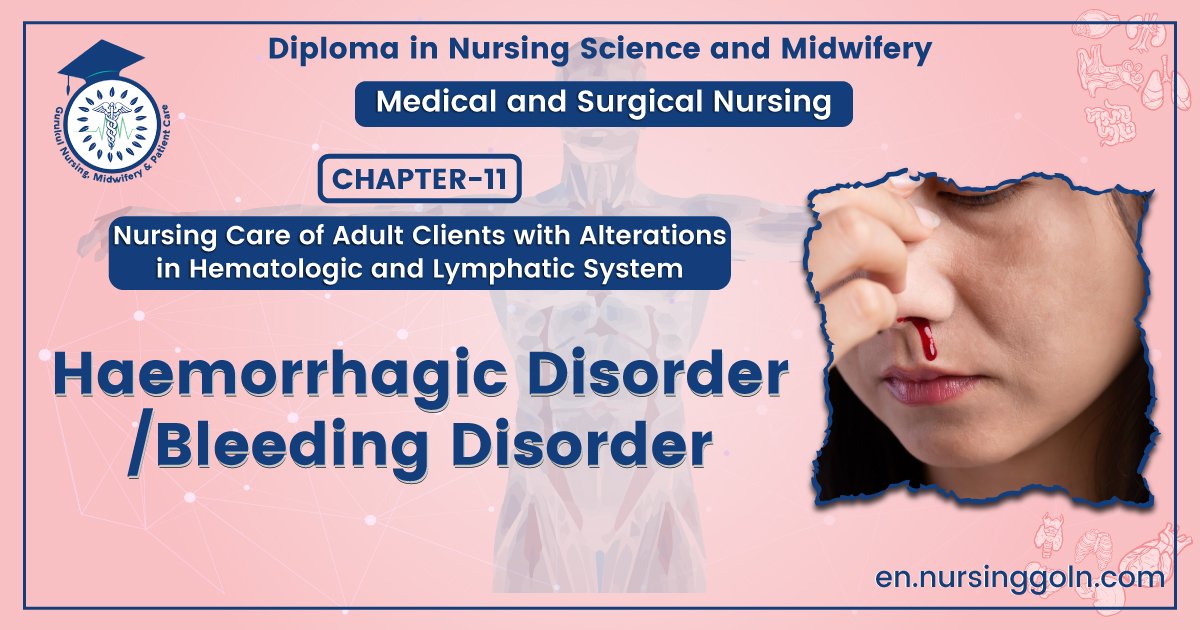Haemorrhagic Disorder / Bleeding Disorder – This course is designed to understand the concept of community health nursing: nurses’ roles and interventions in family health, school health, occupational health, environmental health, elderly health care, gender issues, disaster management and principles and terminology of epidemiology. The aim of the course is to acquire knowledge and skills in community health nursing.

Haemorrhagic Disorder / Bleeding Disorder
Bleeding Disorder
Definition of Haemorrhagic Disorder:
Haemorrhagic disorders are a group of widely differing aetiology, which have in common an abnormal tendency to bleed due to defect in the mechanism of haemostasis.
Clinical feature:
- Spontaneous bleeding into the skin, mucous membranes and internal tissues
- Excessive prolonged bleeding following trauma or surgery
- Bleeding from more than one site.
Blood Clotting Factors:
| Clotting Factor | Synonyms |
| Factor I | Fibrinogen |
| Factor II | Prothrombin |
| Factor III | Tissue factor, tissue thromboplastin |
| Factor IV | Calcium |
| Factor V | Proaccelerin; labile factor,, |
| Factor VII | Serum prothrombin conversion accelerator (SPCA); stable factor |
| Factor VIII | Antihemophilic factor (AHF); antihemophilic globulin (AHG); antihemophilic factor A |
| Factor IX | Plasma thromboplastin component (PTC); Christmas factor, antihemophilic factor B |
| Factor X | Stuart factor, Stuart-Prower factor |
| Factor XI | Plasma thromboplastin antecedent (PTA); antihemophilic factor C |
| Factor XII | Hageman factor |
| Factor XII | Fibrin-stabilizing factor |
Types/ Causes of Bleeding Disorders:
a. Bleeding disorder due to vascular defect:
L. Acquired:
- Purpura simplex (Simple easy bruising)
- Senile purpura
- Symptomatic vascular purpura
✔ Infections-Septicaemia, SBE,meningococcal infection, typhoid & viral infection
✔ Drugs- (NSAID, steroids, penicillin, thiazide & sulfonamide)
✔ Henoch-scholein purpura. (Anaphylactoid purpura)
✔ Uraemia
✔ Cushing’s diseases.
✔ Scurvy.
✔ Dysproteinaemias.
- Systemic disorders:
✔ RA & SLE
✔ Polyarteritis nodosa
✔ Amyloidosis.
B. Congenital
- Hereditary haemorrhagic telangiectasis
- Ehlers-Danlos disease
b. Bleeding disorder due to platelet defect:
L. Thrombocytopenia (platelet count is <150000/mm3):
- Primary thrombocytopenia: Idiopathic thrombocytopenic purpura (ITP)
- Secondary thrombocytopenia: Aplastic anaemia, Leukaemia.
- Neonatal & congenital thrombocytopenia-Mother with chronic ITP.
II. Thrombasthenia: Congental qualitative platelet defect
iii. Thrombocythaemia: bleeding disorder associated with increase platelet count.
c. Bleeding disorder due to coagulation defect:
1. Congenital:
- Haemophilias:
✔ Haemophilia A (classical Haemophilia)
✔ Haemophilia B (Christmas disease)
- Von willebrand’s disease
- Others –
✔ Factor I (fibrinogen) deficiency
✔ Factor II (prothombin) deficiency
✔ Factor V, VII, X, XI, or XII deficiency
✔ Factor XIII (fibrin stabilizing factor) deficiency
B Acquired:
- Vit-K deficiency
- Liver disease
- DIC
- Massive blood transfusion
- Anticoagulant drugs.
Name of Common Bleeding Disorders:
- Idiopathic thrombocytopenic purpura (ITP)
- Dengue fever
- Drugs or chemicals
- Leukaemias
- Aplastic anaemia
- Haemophilias
- Henoch-scholein purpura. (Anaphylactoid purpura)
- DIC

Investigation of Bleeding Disorder:
a. History taking & physical examination:
1. Determine whether vascular/platelet/ congulation disorder.
- Easy bruishing & spontaneous bleeding from blood vessels vascular/platelet disorder or Von Willebrad diseases.
- Haemarthroses & muscle haematoma, & bleeding after injury or surgery congulation disorder.
2. Determine whether generalised haemostatic defect:
- Bleeding from multiple sites, spontaneous bleeding & excessive bleeding after injury.
3. Determine whether it is congenital or a aquiread.
- Family history of bleeding disorder.
- Severe inherited defects apparent in infancy.
4. Relation with surgery :
- Bleeding that starts immediately after surgery indicates defective platelet plug formation & primary haemostasis.
- Bleeding that starts after several hours after surgery suggests a coagulation defect (Secondary haemostasis.)
5. Family history:
- Absence of relatives with clinically significant bleeding does not exclude a hereditary bleeding disorder
- About one-third of haemophilic patient arises in individuals with out a family history of haempphilia
6. History of systemic illness:
- Renal failure
- Hepatic failure
- Paraproteinaemia
- Collegen diseases-RA, SLE & PAN
7. Drug history:
- NSAIDS
- Steroids, penicillin, thiazide & sulfonamide

b. Signs/physical examination:
- Anaemia-CLD, CKD
- Skin-Easy bruising, purpura
- Scars due to poor healing following prolonged superficial bleeding
- Telengiectaasia of lips & tongue -Points to hereditary haemorrhagic telengiectasia
- Muscle-muscle haematoma
- Joint-Haemarthroses
- Stigmata of liver diseases
- Hepatomegaly
- Splenomegaly-especially for hypersplenism
- Lympadenopathy
Routine blood test-
- Hb estimation
- TC of WBC
- ESR
- Blood film-
✔ RBC morphology
✔ DC of WBC
✔ Platelet morphology and count.
c. Screening tests: To defect whether there is vascular, platelet and clotting defect.
i) Vascular defect –
- Platelet count-normal
- Prothrombin time (PT)-normal
- Activated partial thromboplastin time (APTT)-normal
- Bleeding time (BT)-prolonged.
ii) Platelet defects-
- Platelet count-reduced
- Bleeding time-prolonged Prothrombin time-normal
- APTT-normal
iii) Speacial test:
- Prothrombin consumption
- Antiplatelet antibody demonstration
- Clot retraction
- Clot solubility test.
Read more:
